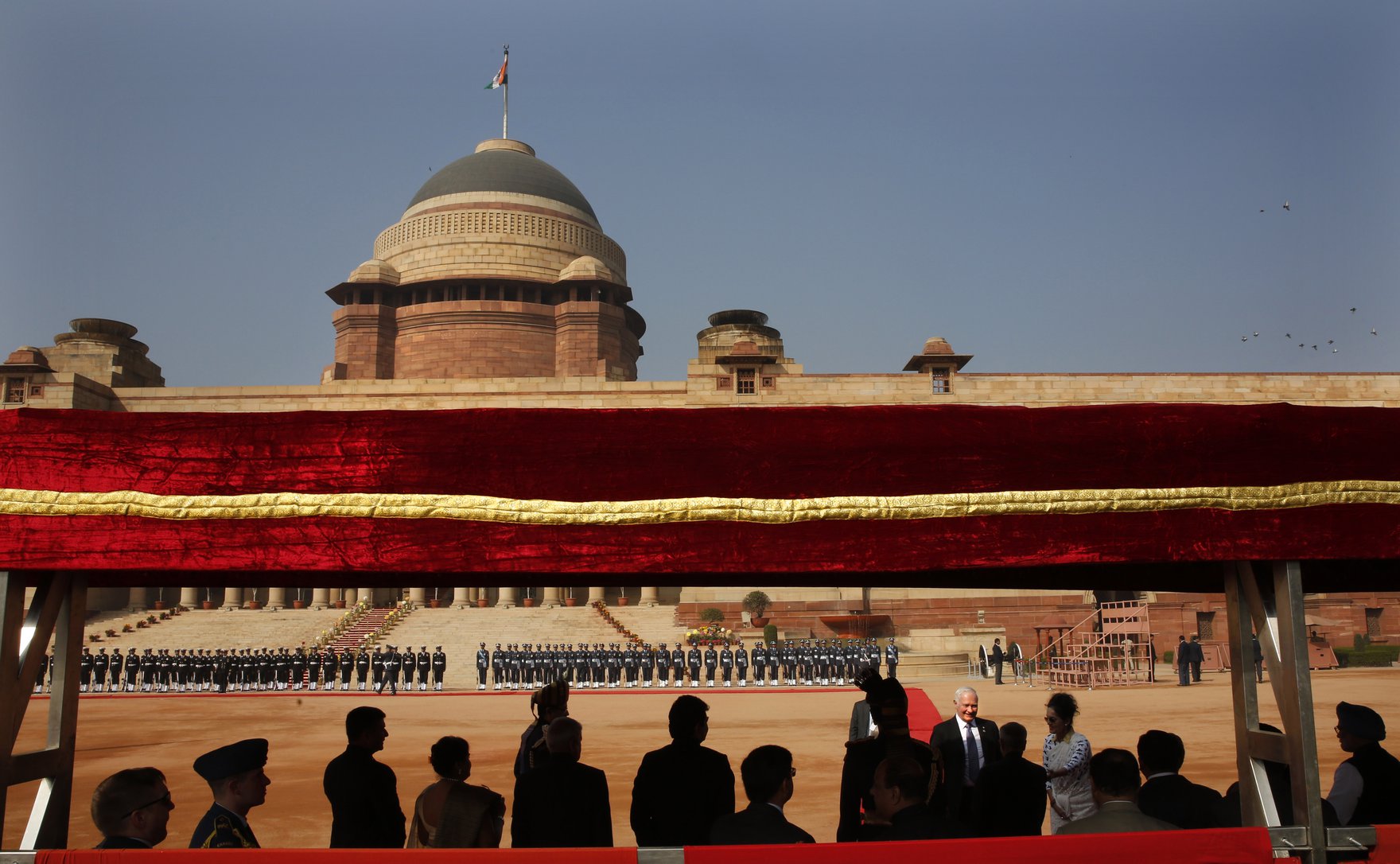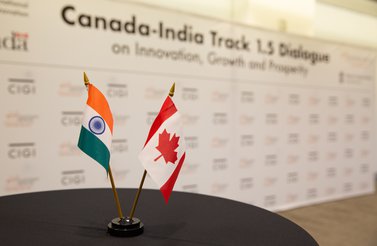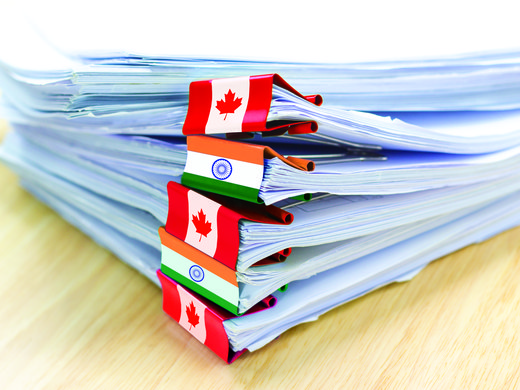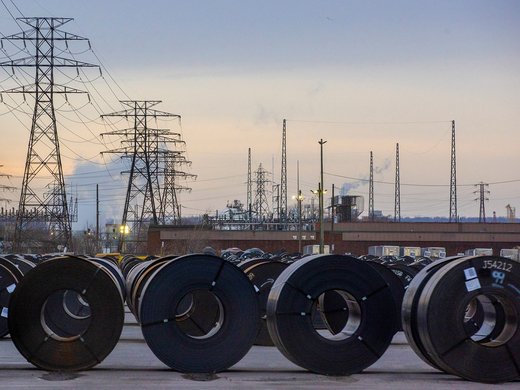On November 22, experts, government officials and business leaders will meet in Mumbai for the second annual Canada-India Track 1.5 Dialogue on Innovation, Growth and Prosperity, convened by the Centre for International Governance Innovation and Gateway House: Indian Council on Global Relations.
The three-year initiative was established in February 2018 to explore opportunities for closer cooperation between Canada and India. Last October, participants at the inaugural session in Ottawa examined the potential for partnership on issues such as cyber security, economic growth and climate leadership.
Here, CIGI president Rohinton P. Medhora speaks with CIGI senior editor Catherine Tsalikis about areas where Canada and India can collaborate and what he hopes will come from this week’s meeting.
How can a partnership with Canada advance India’s global economic agenda — and vice versa?
India is a former developing country — some people would argue it still is, because of the large amounts of poverty in it. But it is also a global economic and political power. As such, India must work with a variety of interests and countries to further its agenda, which remains, I would think, one of enhancing economic prosperity without compromising its own political and other sovereignty.
Working with Canada has to be seen in that larger context. It’s not as if Canada and India are just natural partners. India sees its immediate neighbourhood as one where it has to work well. It certainly sees Southeast Asia as a region from which it has a lot to learn in terms of balancing prosperity with emergence; obviously, the European Union and Britain, for historic reasons; the United States for obvious reasons. Canada, in some senses, might almost seem an afterthought. But it isn’t, for all the usual reasons we know about Canada. Canada punches above its weight, to use that cliché, in a series of global governance issues; it belongs to a number of organizations. And one thing that both have in common is that they’re increasingly risking being frozen out of processes. India needs Canada for the same reason that it needs to work with many middle-power democracies: to burnish its own credentials, to bring oomph to its own economic growth and, in some ways, to show the world that it is now a global power.
On the Canadian side — I said last fall at our meeting in Ottawa that the Canada-India relationship for Canada is like the proverbial $20 bill lying on the pavement. No one picks it up thinking, “it couldn’t be for real, someone else would have picked it up already.” But the fact is India is the underexploited opportunity for Canada. For a number of historic reasons, India has not featured as highly as you would think, considering that it’s a democracy, considering its size, considering the diaspora and the other cultural relations between the two countries. I think Canada sees India almost as a counter opportunity to the more complicated relationship we have with China. If you think of Canada as looking for like-minded countries, and at the same time as looking for strategic balance, India presents itself nicely.
Canada and India, as middle powers, are both invested in a functioning, efficient multilateral trading system. How can they work together to improve that system?
The multilateral trading system is one of those truly global public goods. I would say [it’s] an underappreciated one, meaning we’ve taken it for granted. We’ve let it rust. We’ve almost undercut it by entering into bilateral and plurilateral and regional trade agreements. But the majority of the peace and prosperity that we — not just in the West, but throughout the world — have enjoyed since the end of the last great war is actually because of global free trade that became freer and freer. There are still some pockets where it’s not free, like agriculture and, increasingly, information and data. But really [multilateral trade] is the goose that’s been laying golden eggs that we have not been appreciating.
🔊 CIGI President @RohintonMedhora: "If you think of Canada as looking for like-minded countries, and at the same time looking for strategic balance, India presents itself nicely."
— CIGI (@CIGIonline) November 21, 2019
Learn about the opportunities for partnership between 🇨🇦 and 🇮🇳 at https://t.co/e1BYtVAO2H pic.twitter.com/dlmJfgzY73
Canada and India, for different reasons, have a lot to gain from a functional system, and a lot to lose if it’s dysfunctional. Canada is your classic small, open economy. Something like two-thirds of our economy depends directly or indirectly on trade — and the majority of that, by the way, is still with the United States, so diversification is an issue for us as well. India has traditionally been seen as a closed economy, but it recognizes now the benefits of openness, and by some measures it is a more open economy than, say, the United States or China might be. These are countries that have a lot at stake in the multilateral system — they are not the root cause for why it’s in disarray. And so, if you think of the engine as a coalition of countries that come together and say, “Enough is enough, US and China and others, we really want to save what has served us all so well,” Canada and India, each in their own way, are well positioned to [drive that].
Now, what might that agenda look like? It coincides slightly with the World Trade Organization [WTO] reform agenda, but not entirely. The first place to start, obviously, is the dispute resolution system in which the panel judges at the WTO are in danger of not having quorum. One of the alternate proposals is that all the countries of the WTO, except the United States — in other words, you sideline the United States — recreate that system minus the United States. That’s something I think Canada and India have a joint interest in seeing.
India needs Canada for the same reason that it needs to work with many middle-power democracies: to burnish its own credentials, to bring oomph to its own economic growth and, in some ways, to show the world that it is now a global power.
Then you go beyond that and go, Well, how can the WTO modernize itself? There are a number of initiatives out there. One is to make the WTO more central in the sustainable development and climate change agenda, specifically by using border carbon adjustments, which is a form of tax and subsidy at the border so that you have a global carbon price. The only way that system works is if it’s centred at the WTO. India initially was, and I suspect still is, skeptical of that idea, because it sees it as a scheme to challenge countries that did not create the climate change problem. But, broadly speaking, both countries have an interest in seeing the system work and in seeing the WTO revived.
There are other ways in which the WTO can be modernized with Canada and India at the helm. The global intellectual property agreement TRIPS [the Agreement on Trade-Related Aspects of Intellectual Property Rights] is outdated, and in fact is being bypassed by a series of unilateral and bilateral initiatives. Canada and India are both countries that are effectively net importers of intellectual property but have important innovation sectors within them. So, having a strong and modern TRIPS would be in their benefit.
How can Canada and India work together on global data governance?
There are different dimensions to data governance — let me begin with the one that connects with the previous answer, which is e-commerce, the fastest growing component of global trade. Currently, we don’t have an appropriate global regime for it — there’s another idea for WTO reform, and the WTO is on it, which is to have an e-commerce convention that standardizes aspects of what data flows look like and how privacy and homebase regulations might apply.
But more broadly, we’re Balkanized in three data zones. You have the state-centric China zone, you have the firm-centric US zone, and then in between you have the person-centric GDPR [General Data Protection Regulation] zone in the European Union. These three zones currently cannot talk to each other, meaning you cannot be a firm that operates in all three zones without being offside somewhere. So, there’s that, that we no longer have globalization. More to the point for Canada and India, they don’t belong to either of these three zones. And there’s a number of countries that don’t. So, the question is, what do these countries do? The choice is to create a fourth zone that builds off one of the other three, or to find a way to mediate between these three and make sure that these zones are harmonized in some functional way. I think both have to happen in parallel.
This is a really tall order because there’s some really fundamental issues at play: what is the role of the state? What is the role of the individual? What do privacy, security, openness and democracy really mean? But that’s the nature of global governance. When we created the Bretton Woods system, there were hugely disparate views on the role of trade, on the nature of exchange rates, on why economics should dovetail with peace and political development and political integration. And we found a way forward. Now, we did that by excluding half of the world, behind the iron and bamboo curtains. [Today] data in these different blocks, which you might think of as modern-day iron and bamboo curtains, have to be brought together. The kicker is, unlike in the past, countries have an interest in having global reach and global markets and global influence — one could make the case that all three zones have an interest in talking to each other, because that’s the nature of data and globalization today. In all of that, you have Canada and India, again, different countries, but with shared values, and in some cases shared law, who are well positioned because of their size and reach and history to take the lead, through the G20 [Group of Twenty] and other fora.
India will host the G20 in 2022 — how can Canada play a role in preparing for that?
It’s not as if India needs Canada’s help, but I do think that the countries can work together. I’ve been following the G20 forever, including in its pre-leaders format, and I cannot think of a country that has started this early and this effectively and this earnestly in planning for its G20 year. India will not be chair until 2022; most countries, frankly, don’t get serious about their G20 presidency until about, you know, six months to go, sometimes not even that. I was [in India] a year ago and the establishment there was already seized with the opportunities that G20 stewardship would bring. This could be India’s coming-out party in 2022. This could be the statement of India now being an “arrived” global power, one that is liberal but also cognizant of its national values and national interests.
There are areas in which India could make a mark — we’ve talked about data already, but more broadly, I’d say the role of new technologies and global governance. This is the big greenfield area in global governance: how do we deal with the various issues thrown up by machine learning, by artificial intelligence, by advanced biotechnologies, by multinational digital platforms? Canada has the same interests, in some ways, that India does. And the G20 is actually the right forum for these things to advance because it contains all the countries that matter, and then some.
Given Canada’s very strong foreign affairs and global machinery, I see no reason why Canada wouldn’t be a key partner. Keep in mind that in the G20, the dynamics now are [that] the G2 — the United States and China — are preoccupied with themselves and with each other. The European Union is preoccupied with the very destabilizing low-growth zone in its southern flank, and then some very serious issues in the north, including of course whether the United Kingdom is in or out. The United Kingdom is distracted too. Japan is coming out of its decade-long funk, but is still not as active as it might be in global governance. When you add all of that up, and you’re India and you’re facing this summit in two, two-and-a-half years, it makes sense to talk to Canada more often and more frequently than you might otherwise imagine.
What are you hoping will come out of this week’s meeting in India?
When we designed this initiative, our thought very much was that the Canada-India relationship had not been fully utilized to both countries’ benefit. One reason was that the formal and informal mechanisms and tables that you need for this kind of thing to blossom didn’t exist. And so we thought, Wouldn’t it be nice to create the table at which the research and analytical sector, the policy people, the NGOs [non-governmental organizations] and certainly the business sector can meet [to discuss] key issues, exchange views and create the soft tissue on which a stronger and deeper relationship could be built. That’s what we’ve been doing for the past year, year-and-a-half. And that’s what we expect to continue to build on this week in Mumbai.
If someone asked me, “What would you like to see?” I’d say, “Progress.” Progress on the many things that we’re talking about — traditional and non-traditional energy cooperation, cooperation on the G20 and WTO reform agendas as India picks up steam with its G20 stewardship in 2022, progress on cybersecurity, progress on innovation strategies. If we have, as we already do, more people attending, more interest each time we meet, then we’re building toward exactly the thing that our prime minister said in his statement when we launched this initiative in Mumbai over a year-and-a-half ago, which is that these are the countries that should work together, and that initiatives like this one “allow us to move forward — together — to pursue our common interests.”
This interview has been edited for clarity.




